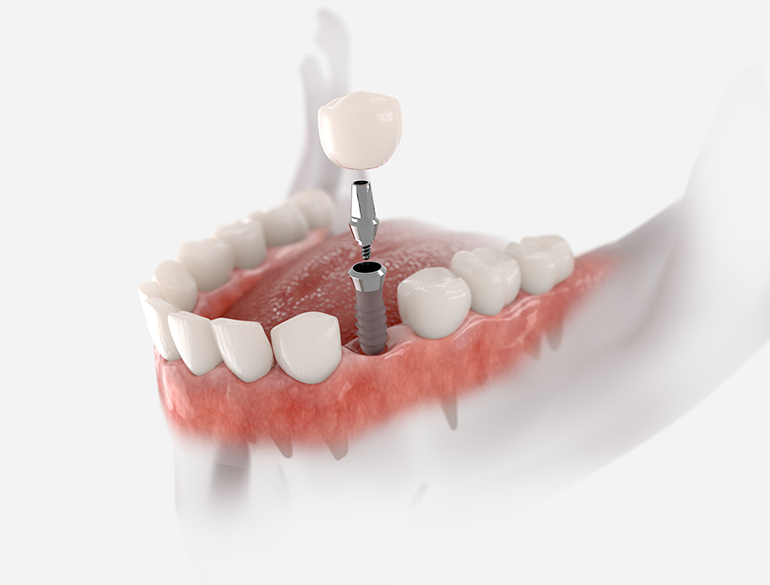Dental Sense Fundamentals Explained
Dental Sense Fundamentals Explained
Blog Article
Some Known Details About Dental Sense
Table of ContentsThe Main Principles Of Dental Sense Not known Incorrect Statements About Dental Sense The 6-Minute Rule for Dental SenseAbout Dental Sense
are clinical tools operatively implanted into the jaw to recover an individual's capability to chew or their look. They offer support for man-made (phony) teeth, such as crowns, bridges, or dentures. When a tooth is lost because of injury or illness, an individual can experience difficulties such as quick bone loss, defective speech, or adjustments to chewing patterns that cause pain.Oral implant systems consist of an oral implant body and dental implant abutment and might likewise include an abutment fixation screw. Dental implant vs bridge. The oral implant body is operatively put in the jawbone instead of the tooth's origin. The oral implant joint is typically connected to the dental implant body by the abutment fixation screw and prolongs via gum tissues into the mouth to sustain the attached fabricated teeth
(https://dental-sense.jimdosite.com/)Framework of The Dental Implant System selecting oral implants, speak with your oral provider regarding the possible benefits and dangers, and whether you are a prospect for the treatment. Things to take into consideration: Your total wellness is an essential consider establishing whether you are a great prospect for oral implants, the length of time it will certainly require to heal, and for how long the dental implant may remain in location.
Cigarette smoking might impact the healing procedure and decrease the long-term success of the implant. The healing process for the dental implant body might take several months or longer, during which time you generally have a short-term joint instead of the tooth. the dental implant treatment: Carefully comply with the oral hygiene guidelines provided to you by your oral service provider.
The 8-Second Trick For Dental Sense
Implant failure can lead to the demand for an additional medical procedure to take care of or replace the dental implant system. Recovers the capacity to eat Recovers cosmetic appearance Helps keep the jawbone from shrinking because of bone loss Preserves the wellness of the bordering bone and periodontals Helps keep nearby (close-by) teeth secure Boosts top quality of life Damage to surrounding natural teeth during implant placement Injury to the surrounding tissues throughout surgical procedure, such as sinus perforation Injury throughout surgical procedure (for instance, crack of bordering jawbone) Inadequate function, such as seeming like the teeth do not bite with each other usually A sensation that the tooth is loosened or turning in place resulting from a joint screw loosening up Implant body failure (looseness of the implant body) because of systemic infection, which might be more probable in people with uncontrolled diabetes due to local infection in bone and gum tissues sustaining the implant body due to postponed healing, which might be find here more probable in individuals who smoke Difficulty cleansing the periodontals around the implant, resulting in poor oral hygiene Neglected gum condition Post-surgical pins and needles as a result of nerve impingement or damage Always alert health treatment suppliers and imaging specialists that you have dental implants before any type of magnetic resonance imaging (MRI) or x-ray procedures.
FDA is not familiar with any type of adverse occasions reported for MRI or x-ray treatments with oral implants. Dental implants systems are usually made of materials that adhere to global consensus standards of the International Company for Standardization (ISO) or ASTM International. These requirements have information of what makes a secure product.

An oral implant is a framework that changes a missing tooth. With screw-like gadgets, the doctor inserts a dental implant into the jawbone, and it acts as a support for a fabricated tooth, called a crown.
The Buzz on Dental Sense
Some people are not qualified for oral implant surgical treatment. It is for oral specialists to operate on people with: intense illnessuncontrollable metabolic diseasebone or soft tissue disease or infectionIf these issues are solved, an individual can have the surgery. In, oral surgeons refrain from operating people with: If individuals with any of the above go through oral implant surgical procedure, there is a higher threat of the implant failing.

Oral dental implant surgery is a personalized process. It's not the same for everyone. The following gives a general overview of what you can expect your dental expert, oral specialist, periodontist or prosthodontist to do: Position the dental implant operatively. Give you time to recover. Attach the article and last crown, bridge or denture.
Next off, your cosmetic surgeon will meticulously place the oral implant into your jaw. If your implant is near the front of your mouth, your dentist will make a momentary tooth for you to wear until you heal.
The 4-Minute Rule for Dental Sense
Your copyright can inform you what to expect in your situation. Throughout the healing stage, your jawbone must fuse to the dental implant. This process, called osseointegration, is vital for security and long-lasting success. This procedure can take anywhere from 3 to nine months. In some instances, it might take much longer.
When your implant heals, your dentist can connect the joint (little adapter post) and your final restoration (crown, bridge or denture). This normally takes about one hour to finish and might require a second minor surgical treatment. You should not really feel any pain during your dental implant treatment since your company will make use of medicine to numb your periodontals.
Report this page